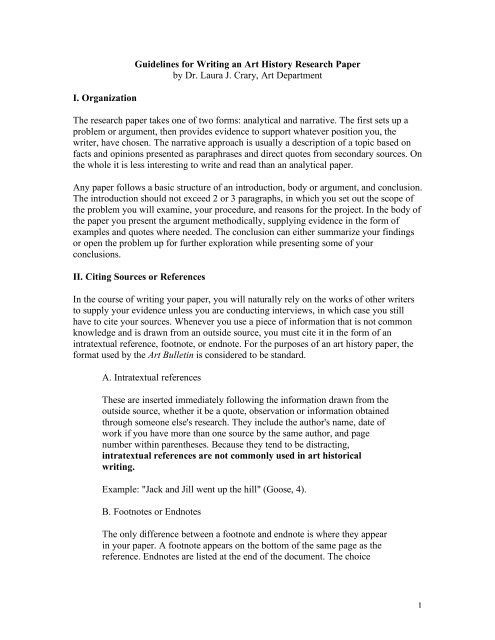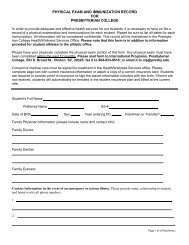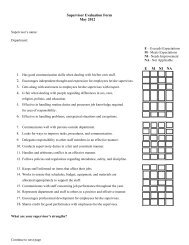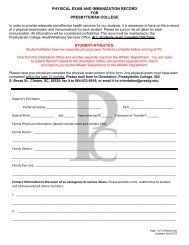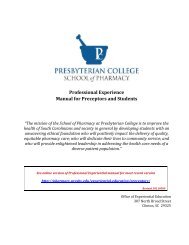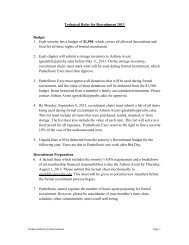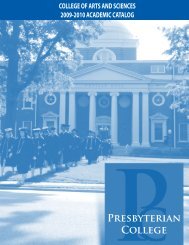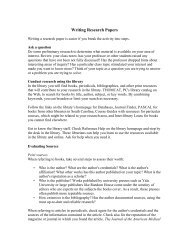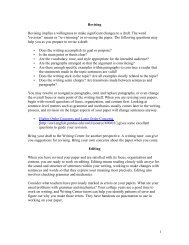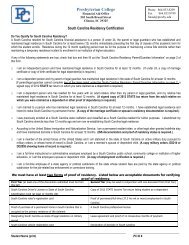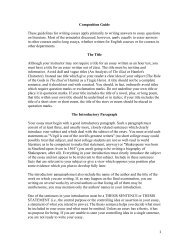Guidelines for Writing an Art History Research Paper
Guidelines for Writing an Art History Research Paper
Guidelines for Writing an Art History Research Paper
Create successful ePaper yourself
Turn your PDF publications into a flip-book with our unique Google optimized e-Paper software.
mostly depends on whether your software has a footnote function or if youhave to keep track by h<strong>an</strong>d, in which case the endnote system is easier.All the following examples come from <strong>Art</strong> BulletinExample: Single author text1. James Clif<strong>for</strong>d, The Predicament of Culture: Twentieth-Century Ethnography,Literature, <strong>an</strong>d <strong>Art</strong>. Cambridge, MA <strong>an</strong>d London, 1988, 11.Please note punctuation <strong>an</strong>d that page number is not preceded by 'p.' or 'pp.' The title iseither underlined or italicized, not bold-face or <strong>an</strong>y other combination.Example: Essay from <strong>an</strong> <strong>an</strong>thology2. Russell Ferguson, "Invisible Center," In Out There: Marginalization <strong>an</strong>d ContemporaryCultures. Russell Ferguson et al., ed., New York, 1990, 9.Example: <strong>Art</strong>icle from Journal or Periodical3. Anthony dePalma, "A Scholar Finds Huck Finn's Voice in Twain's <strong>Writing</strong> about aBlack Youth," New York Times, July 7, 1992, A16.4. David Craven, "Abstract Expressionism <strong>an</strong>d Third World <strong>Art</strong>: A Post-ColonialApproach to 'Americ<strong>an</strong>' <strong>Art</strong>," Ox<strong>for</strong>d <strong>Art</strong> Journal, XIV, no. 1, 1990, 44-65.5. George Schuyler, "The Negro <strong>Art</strong> Hokum," The Nation, June 16, 1926, repr. in Nath<strong>an</strong>Huggins, ed., Voices from the Harlem Renaiss<strong>an</strong>ce. New York, 1976, 309-12.Example: Essay from Exhibition Catalogue6. Gerardo Mosquera, "Modernity <strong>an</strong>d Afric<strong>an</strong>ia: Wifredo Lam on his Isl<strong>an</strong>d," in WifredoLam. exh. cat., Barcelona, 1993, 174.If you cite the same work immediately following the first citation:7. Ibid.If the second note follows immediately but has a different page number:8. Ibid., 175.If you repeat a source later in the notes with other sources in between:9. dePalma, A17.2
All footnotes are numbered successively. You do not repeat the number of the earliercitation.10. Internet sources should have the author of the page (if known), the title of the page,<strong>an</strong>d the address <strong>an</strong>d date searched.III. IllustrationsYou should include a reproduction of <strong>an</strong>y work of art that you discuss in your paper. Theproper <strong>for</strong>m <strong>for</strong> this is to cut the photocopied image out <strong>an</strong>d paste it onto <strong>an</strong>other sheet ofpaper or to sc<strong>an</strong> the image in by computer. Under the image you should have thefollowing in<strong>for</strong>mation:• the illustration or figure number that you have assigned it in the text.• artist's name, title underlined or italicized (not in quotation marks), <strong>an</strong>d the date ofthe work. This in<strong>for</strong>mation c<strong>an</strong> either be included in the text at the time youdiscuss the work or be placed under the illustration or in a separate list ofillustrations at the end of the paper.• source of illustration. This resembles footnote <strong>for</strong>m: author, title of publication,place of publication, date <strong>an</strong>d page or plate number. If from a periodical, justfollow that <strong>for</strong>m.IV. BibliographyThe bibliography is a list of all the works you have consulted <strong>for</strong> the writing of the paper,including those which were not cited in your footnotes, but not including those that youchecked out of the library but didn't end up using because they didn't really relate to yourtopic but your bibliography looks awfully short with just two works on it.Bibliographies are not numbered. They are always in alphabetical order by the author'slast name. More th<strong>an</strong> one entry by the same author is indicated by a line.Examples of bibliographic <strong>for</strong>m from <strong>Art</strong> BulletinBois, Y.-A., "Painting as Trauma," <strong>Art</strong> in America, LXXVI, no. 6, June, 130-41, 172-73._____, 1992, "The Semiology of Cubism," in Picasso <strong>an</strong>d Braque: A Symposium. I.Zel<strong>an</strong>sky, ed., New York, 169-208.Buci Glucksm<strong>an</strong>n, C., "Catastrophic Utopia: The Feminine as Allegory of the Modern,"in The Making of the Modern Body: Sexuality <strong>an</strong>d Society in the Nineteenth Century. C.Gallagher <strong>an</strong>d T. Laqueur, ed., Berkeley, 1987, 220-29.Daix, P., 1993, Picasso: Life <strong>an</strong>d <strong>Art</strong>. H. O. Emmet, tr<strong>an</strong>s., New York.Once again, Internet sources should have the author of the page (if known), the title of thepage <strong>an</strong>d date searched. You c<strong>an</strong> alternatively put the date of publication after the place3
of publication. The import<strong>an</strong>t thing is to be internally consistent. Choose a <strong>for</strong>mat <strong>an</strong>dstick to it.V. General Points <strong>an</strong>d Frequent Errors1. Watch <strong>for</strong> the difference between 'effect' <strong>an</strong>d 'affect.' Generally if it's averb you w<strong>an</strong>t 'affect' <strong>an</strong>d 'effect' <strong>for</strong> a noun. Generally. If you're not sure,look it up in the dictionary.2. Note well the difference between the contraction of 'it is'--it's--<strong>an</strong>d thepossessive pronoun its. The possessive pronoun has no apostrophe.3. Look <strong>for</strong> repeated words <strong>an</strong>d terms. It may seem that 'painting' has nosynonyms. It does. Another word that art-writers tend to overuse is'influence.' Try to find a more precise word to describe what you me<strong>an</strong>.Example: Degas's paintings were a big influence on JoséFul<strong>an</strong>o.Compare to: José Ful<strong>an</strong>o used Degas's treatment of youngballerinas as the basis <strong>for</strong> his studies of salsa d<strong>an</strong>cers.4. Try to avoid the passive voice.5. Note the difference between single quotation marks (' ') <strong>an</strong>d double (“"). Single ones denote a word or phrase itself, not what it me<strong>an</strong>s. Example:I wrote about the verb 'to be.' Double quotation marks denote a quote orset off a phrase <strong>for</strong> its me<strong>an</strong>ing. He likes to play "good cop" to her "badcop."6. 'Feel' <strong>an</strong>d 'believe' me<strong>an</strong> different things. In a research paper, yougenerally me<strong>an</strong> 'believe' rather th<strong>an</strong> 'feel.' Example: I believe that the artistmade such ugly paintings to express his feelings about the ugliness of theworld. Or: I felt a sudden pain in my head when I looked at his painting.7. 'Medium' is singular. 'Media' is plural.8. PROOFREAD!9. Any other pet peeves of your instructor as noted by that person.4


